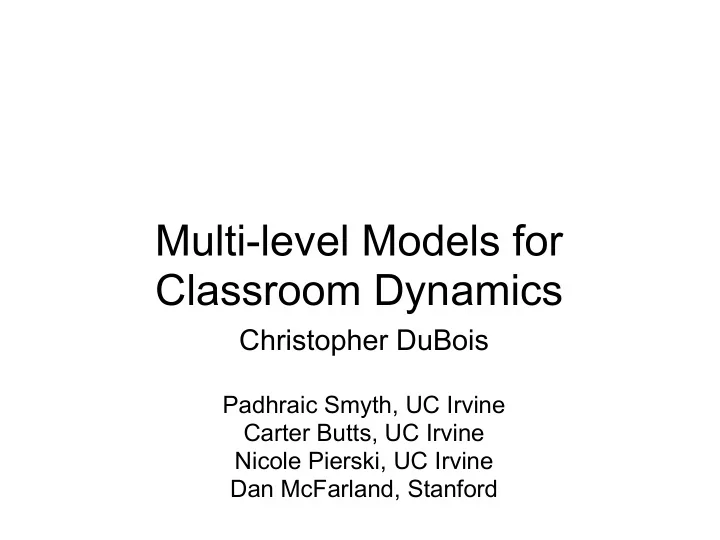

Multi-level Models for Classroom Dynamics Christopher DuBois Padhraic Smyth, UC Irvine Carter Butts, UC Irvine Nicole Pierski, UC Irvine Dan McFarland, Stanford
The Data High school interactions (McFarland 2001) 650 classroom sessions Covariates about class ● e.g. subject, teachers Covariates about individuals ● e.g. race, extracurriculars
The Data Nodes arranged (roughly) according to seating chart Teacher interactions common Local interactions common
Goals Describe how the probability of each interaction varies with a set of covariates Pull apart relative contribution of: ● actor covariates ● current context ● conversational dynamics Make inferences about event sequences: ● within classroom sessions ● across classroom sessions Long-term question: ● Given covariates about a classroom, can we predict aspects of the dynamics? (e.g. amount of reciprocity in interactions)
Notation Rate/hazard at time t of the interaction initiated by individual i and directed towards j Covariates about interaction (i,j) at time t Use a (positive) linear predictor to model the hazards: ● Hazards depend on past history and covariates. ● Include rates that individuals "broadcast" to entire classroom.
Model specification: "Autocorrelation": Sender/recipient effects: ● recency (sender/receiver) ● race (e.g. rank of individual in ● gender list of most recent) ● is_teacher ● current event and Event effects: previous event are both ● teacher_student (teacher,broadcast) ● teacher_broadcast ● are_friends "Context" of event: ● number_shared_activities ● Lecture ● Silent time Participation shifts (Gibson 2003) ● Groupwork ● Reciprocity (AB-BA) ● Turn taking (AB-BY) ● Others...
Model Assume is constant between events. time \displaystyle\prod_{k=1}^M \lambda_{i_k,j_k}(t_k) \prod_{ij} \exp\{ - (t_k - t_{k-1}) \lambda_{ij}(t_k)\}
Model Full likelihood for history of events: \displaystyle\prod_{k=1}^M \lambda_{i_k,j_k}(t_k) \prod_{ij} \exp\{ - (t_k - t_{k-1}) \lambda_{ij}(t_k)\}
Model Full likelihood for history of events: \displaystyle\prod_{k=1}^M \lambda_{i_k,j_k}(t_k) \prod_{ij} \exp\{ - (t_k - t_{k-1}) \lambda_{ij}(t_k)\}
Model Full likelihood for history of events: Hazard of k'th observed event p(A | \beta) = \displaystyle\prod_{k=1}^M \frac {\exp\{{\beta^T x_{a_k}(t_k)}\}} {\displaystyle\sum_{a' \in R}\exp\{\beta^T x_{a'} (t_k)\}}
Model Full likelihood for history of events: Survival function for each event, representing the fact that no event occurred between event k-1 and event k p(A | \beta) = \displaystyle\prod_{k=1}^M \frac {\exp\{{\beta^T x_{a_k}(t_k)}\}} {\displaystyle\sum_{a' \in R}\exp\{\beta^T x_{a'} (t_k)\}}
Model Mapping to standard survival analysis methods: ● Risk set : all possible interactions among individuals ● Covariates are time-varying (and dependent on all previous events) ● Each event: ○ one observed failure time ○ times for other events are censored Alternative perspectives: ● Continuous time process with N^2 states
Modeling Several Sequences Parameter estimation: ● Can use standard techniques (e.g. Newton-Rapheson) to obtain maximum likelihood estimates Problem: ● Some event sequences have few events ● Some effects may have few relevant events Today's approach: ● Share information across classroom sessions via a hierarchical model
Modeling Event Sequences Event model parameters Observed event sequence for session j Event covariates
Multilevel Relational Event Model Upper-level parameters Event model parameters Observed event sequences for J sessions Event covariates
Multilevel Relational Event Model Observed event sequences for J sessions Event covariates
Inference Iterated conditional modes (ICM): ● Fit individual models to obtain beta for each session that maximizes the log posterior ● Obtain estimates for the upper-level model theta conditioned on the betas ● Iterate using theta as initial estimates for each beta. Draw samples from posterior centered at mode via MH.
Hierarchical Model: Sender Receiver Event-level Dynamics
Shrinkage
Posterior-predictive checks: Degree
Posterior-predictive checks: "P-shifts" Comparing p-shift statistics of observed data and data simulated using the parameter estimates for two classroom sessions.
Takeaways and future directions Proof of concept: ● Can model event data using actor covariates and conversational dynamics ● Hierarchical modeling useful in this setting ● Can begin to ask questions at the network level: use models of observed networks to generalize to new networks How do dynamics depend on the "context" of event? ● Lecture, Silent time, Groupwork Multilevel modeling with session-level covariates: ● racial mixture ● survey results about the classroom session
Takeaways and future directions Predictive evaluation: ● Predict out-of-sample events within a classroom ● Predict out-of-sample session information "Big Data": ● Likelihood computations are intensive. ● Small group dynamics (~20 actors), but many networks (~280-600), many effects (~10-30) What does the model predict? ● Simulate ramifications (like in agent-based modeling)
Thank you
Multilevel Relational Event Model Session-level covariates Event model parameters Observed event sequences for J sessions Event covariates
Model Partial likelihood for sequence of events A: For each event, k: P( next event is a=(i,j) | some event occurs ) Alternatively, can consider a full likelihood where inter-arrival times have a parametric form (e.g. exponential). p(A | \beta) = \displaystyle\prod_{k=1}^M \frac {\exp\{{\beta^T x_{a_k}(t_k)}\}} {\displaystyle\sum_{a' \in R}\exp\{\beta^T x_{a'} (t_k)\}}
Multilevel Relational Event Model
Outline Data Goals Model ● Likelihood ● Specification ● Hierarchical extension ● Inference Preliminary results Future directions
Recommend
More recommend